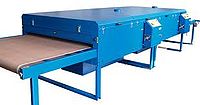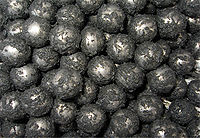Delta Dryers
The Delta Dryers can be either Belt Dryers or Ball Dryers.
(Ball) Delta Dryers
Introduction
Huge amounts of sludge are formed in water purification, soil cleaning, dredging activities, mining and many other industrial processes. Considerable fractions are contaminated and must either be stored or treated. Due to uncertainties of landfilling with regard to long term risks, processing is often more attractive. Different processing routes for contaminated sludge involve sand separation, mechanical dewatering, and thermal drying of the residual fines. For mineral sludge types the next and last treatment step concerns a process of sintering or cold immobilization. The end product can then be sold as a building material. For sludge types with high organic content, the drying treatment increases the calorific value and makes the cake more suitable as a (green) fuel. Unfortunately, the thermal drying step contributes significantly to the total costs of sludge treatment. Most existing dryers consume too much energy, require expensive air treatments, and are susceptible to the composition of the cake. In order to make processing of sludge more attractive, the Delft University and DHV worked together and developed a new drying technique, called Delta dryer.
The Delta dryer concept
The Delta dryer mixes the wet cake with hot, steel balls and dries the mixture in a vacuum atmosphere. The steel balls enhance heat transfer to the sludge; the absence of air eliminates the problem of air cleaning and gives the opportunity to recycle part of the heat of evaporation. First, the wet cake is mixed with hot (~120°C) metal balls, and transported upwards by a dish elevator. The mixture is fed into the first of two Screw Conveyors, where it gradually dries up and cools off, as the sludge water evaporates and escapes through vapour bridges. At the end of the screw conveyer a condenser and vacuum pump get rid of remaining sludge water and small amounts of air. The dried cake (~50°C) is now separated from the balls and collected. The balls run into the second screw conveyor and move in the opposite direction parallel to the first conveyor. During this transport, the balls are brought in contact with the other ends of the vapour bridges, and step-by-step reheated using steam that was formed in the first conveyor. Because of this, only a small additional heating stage is needed to bring the temperature back to 120°C. This final heating stage takes place in a steam vessel, separated from the rest of the installation by sluices. A sloping dewatering screen inside the steam vessel simultaneously removes the condensate. Then, the balls are mixed with wet cake, and the cycle starts over again.
(Belt) Delta Dryers
Delta Dryers can be offered in belt widths of 91 to 152 cm (36” to 60”). The Delta Dryers are a good choice for Electric Curing of Screen Printed Textiles. It uses Ceramic Elements, which offer the highest production rates while being extremely efficient. The Industrial Thermal Insulation prevents heat from penetrating the production environment. The fast cure rates and high throughput maximize drying capacity and minimize costs per unit cured.
Working Principle
Forced air combined with an array of Ceramic Heaters and a sophisticated Proportional Integral Differential (PID) Temperature Controller allows the dryer to power up quickly yet avoid maximum amperage loads during the initial system warmup. PID Technology maintains even temperatures during production by phasing on and off rather than the full-load/no-load approach. Dedicated blowers evenly control circulation and exhaust right from the main control panel along with operational adjustments such as belt speed, temperature, etc.
Controls
Digitally controlled set temperatures are ensured by a fuzzy-logic controller, which responds to ambient temperature changes by keeping chamber process heat within 1° of target temperature at the thermocouple.
Both entry and exit openings are adjustable, and the large rollers ensure positive belt tracking. Maintenance is simplified with easy-to-reach filters and lubrication points with a simplified shut-down sequence keep the blower and belt running until the chamber has completely cooled.

